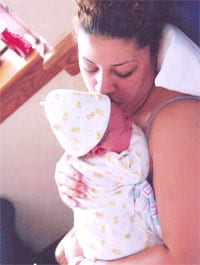Progress Comes Into Focus Cooley Dickinson Hospital’s $5 Million MRI Center Is Open For Business
As the scope and effectiveness of magnetic resonance imaging technology expanded over the past decade, the MRI services at Cooley Dickinson Hospital were starting to seem, well, restricted.
That’s not the case any longer, however. After a $5 million investment and an aggressive, six-month construction schedule, the Northampton hospital’s new MRI Center is open for business.
“For the last nine years, MRI has been performed on-site in a mobile trailer unit. And when we first offered MRI, we were open two days a week,” said Nancy King, manager of Radiology at CDH. Now, scans are performed six days per week in the new, two-story addition on the hospital’s south side.
The center, located on the first floor of the addition, houses an MRI treatment area, a patient waiting lounge, changing rooms, consultation areas, radiologist reading areas, and rooms for film storage. “The center was designed for comfort,” King said, noting that the rooms are spacious and well-lit, and the MRI room itself has a large window with a view on natural surroundings.
But comfort is only a small part of the large-scale improvement the MRI center brings to CDH’s imaging services. The expensive, advanced technology brings the hospital’s radiology work firmly into the 21st century, King told The Healthcare News.
A Clearer Picture
Nearly half of the $5 million project cost, in fact, went toward the purchase of a new MRI machine featuring a state-of-the-art, high-powered magnet, said Dr. Charles J. Bernstein, chief of Radiology.
“The new magnet will provide us with superior image quality,” he said. “Like a photograph, better resolution means we are looking at a clearer image.”
The magnet will also offer referring physicians the opportunity to request advanced diagnostic capabilities, including high-quality central nervous system and peripheral angiography (arterial) tests, as well as full-body imaging tests, some of which were not previously available with the mobile unit, he added.
But new imaging technology offers patients more than highly accurate results — it also reduces the time, invasiveness, and anxiety often associated with MRI work.
“A scan that used to take 45 minutes could be cut to a 20-minute procedure,” Bernstein said. “Vascular imaging, for example, with the new machine reduces scan time by more than one hour. We now have better equipment that is more precise, so the new MRI will definitely limit the need for many invasive diagnostic angiography procedures.”
In addition, the MRI machine is designed to reduce a patient’s feelings of claustrophobia — a common fear associated with imaging procedures.
“By today’s standards, the MRI is extremely wide and open at each end,” King said. The wide openings, she explained, allow light and a steady stream of air inside the machine, while fans circulate fresh air. Mirrors allow patients to monitor their surroundings, and prism glasses, available upon request, allow them to see outside the MRI.
Of course, she was quick to note, a patient’s comfort depends on the part of the body being scanned, and in some cases, there is no way to completely remove the ‘closed-in’ sensations. For example, having an MRI taken of the knee is similar to lying comfortably on a cushioned bed, while a scan of the brain may still promote feelings of anxiety in some patients.
“All MRIs, even the machines marked as ‘open MRIs,’ require close proximity to the patient’s head. There is no way around it. We deal with each patient’s needs on an individual basis,” King said, explaining that technologists work with patients to assess their level of claustrophobia prior to undergoing a procedure.
Imaging Is Everything
Simply put, Bernstein said, it is important that patients feel comfortable with the MRI experience because it is becoming more and more important in general medicine.
In fact, he asserted, MRI is now considered the most advanced procedure available to diagnose many conditions and injuries.
Using strong magnet and radiofrequency waves to produce images of internal organs, muscles, connective tissues, or the central nervous system, MRI gives doctors a wealth of information more quickly and more accurately than past tests, procedures, and even, in some cases, exploratory surgeries. MRI, Bernstein noted, doesn’t use radiation, making it the most painless and least invasive way, in many cases, of obtaining information.
The increasing number of MRI exams more than justifies the cost of the new equipment and space, said Margaret Airoldi, CDH’s director of Ambulatory Services, who added that the hospital’s participation in the Dartmouth-Hitchcock Alliance afforded it the borrowing power to move the project forward.
Not that the effort is complete by any means. The second floor of the MRI Center, which will house an expanded roster of imaging services such as CT scans and ultrasound, will be completed in the fall.
Meanwhile, the hospital is considering adding Sunday MRI appointments to the current six-day schedule in the future, depending on the needs of referring physicians.
The important thing, administrators say, is that the space and resources needed to provide such a schedule, not an option in the old mobile unit, are now in place.
As a result, the future of imaging services in Northampton is looking brighter — and clearer.





Comments are closed.